 Stephen Mapes established the Mapes Piano String Company in 1912 and shortly thereafter in 1918 it was purchased by John Adam Schaff. Now 4 generations later and employing 125 people in a space of 200,000 square feet, Mapes produces piano wire for many of the pianos we play on today. This month I had the pleasure of sitting down with Andy Wilson from Mapes to discuss some of the basics of piano string making.
Stephen Mapes established the Mapes Piano String Company in 1912 and shortly thereafter in 1918 it was purchased by John Adam Schaff. Now 4 generations later and employing 125 people in a space of 200,000 square feet, Mapes produces piano wire for many of the pianos we play on today. This month I had the pleasure of sitting down with Andy Wilson from Mapes to discuss some of the basics of piano string making.
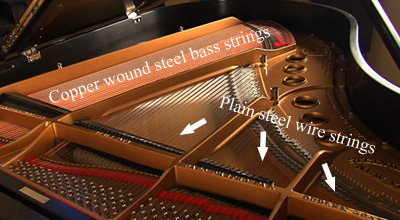
Glen Barkman: Mapes is the oldest piano wire maker in North America. How old is the Mapes company?
Andy Wilson: Mapes is not only the oldest but the ONLY piano wire maker in North America. Established in 1912, our company is 103 years old this year.
What exactly does Mapes manufacture?
Mapes manufactures piano wire, spring wire and specialty wire.
My division looks after piano wire. On any piano you’ll see that there are 2 different kinds of strings. The top 2/3rds of the piano are plain steel wire that we manufacture. Just by looking at them with the naked eye they look the same but there are actually many different sizes of wire on a piano. The bottom 1/3rd contain strings with a steel core wrapped with copper to make the lower tones of a piano. Mapes manufactures both the plain steel wire as well as custom bass strings for pianos.
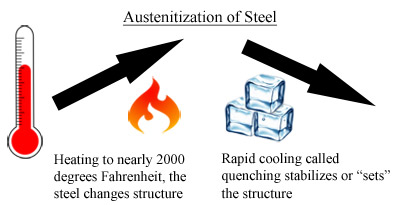 Both the steel wire and the core of the bass strings are drawn wire correct? Can you tell us a little about the drawing process?
Both the steel wire and the core of the bass strings are drawn wire correct? Can you tell us a little about the drawing process?
In order to make great sounding strings you need to start with good raw material. There are over 3,500 grades of steel. We have a steel mill that makes high grade steel to our requirements. So to begin with, you need to specify the chemistry – one of our closely guarded secrets. Before getting into drawing wire, it goes through a process called austenitizing where we heat up the steel to 2000 degrees and then “quench” or cool it again. This changes the structure of the steel.
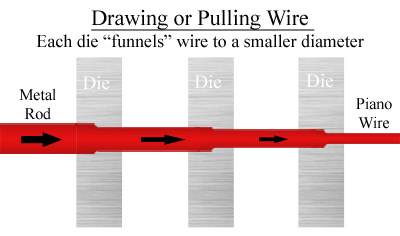
We then press the steel through a funnel which is also called a die. It is pulled or drawn through the die where each time it reduces in diameter by as much as 30%. Think of steel like a piece of wood. Wood has pores or grain. Each time the steel gets reduced, the grain or fibers also get compressed. Heating opens up the “grain” in the steel while the cooling process stabilizes or sets the structure of the steel. So in piano wire making, there are at least 3 heating occurrences and 4 drawing processes to make the finished size.
In your opinion what makes for a great piano string in terms of singing tone?
There are three elements which make great piano strings – First you need great raw material. Chemistry is so important. Second, you need perfectly round wire. And third, when making bass strings, you need correct and consistent tension of the copper wrapped around the steel. Without these 3 necessary components, you could end up with unwanted vibrations which can lead to an inferior tone. Out of shape roundness causes distortions. In order to make a piano string vibrate freely, our job is to manufacture in such a way that it does not interfere by having any anomalies.  When the hammer of a piano strikes that string, the vibration moves up and down the wire. Any interference alters that tone. So it’s our goal to make as round and as pure of a string in such a way that it does not obstruct or alter that vibration.
When the hammer of a piano strikes that string, the vibration moves up and down the wire. Any interference alters that tone. So it’s our goal to make as round and as pure of a string in such a way that it does not obstruct or alter that vibration.
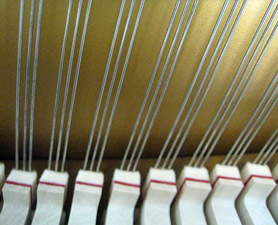
How many sizes of treble piano wire does Mapes offer?
We make sizes from 12-22 in half sizes (12, 12 ½ , 13, 13 ½ etc) and then 23-27 in whole sizes. So we make 25 different sizes of piano wire. Each size is one thousandth of an inch (about 0.025 of a millimetre increments) – approximately one third the thickness of a human hair with tolerances of 3/10ths of one thousandth.
The history of drawn wire seems to have been established in about 1840. With technology, how has the process been refined or made more efficient over the last 175 years?
Over the years, the raw materials have definitely improved. But within our own company, the basic premise is the same but what have changed are the controls. So instead of simply heating up the steel, we have accurate sensors and controls that are indicating more precise measurements of temperatures, tolerances, speed indicators and cooling controls.
Are piano wires ever coated at least to prevent corrosion or does that interfere with tonal properties?
Nickel electroplating is actually the finishing step of piano wire for silver look. That might create some corrosion prevention but electroplating is only microns thick. Some think it’s polishing but it’s actually electroplating. Any piano wire however will rust over time because that’s just the nature of steel. When it comes to copper coatings in the bass, I have not found anything relating to coatings that doesn’t affect tone.
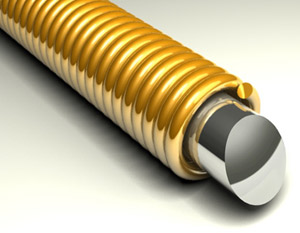
How are bass strings made?
Bass strings are a combination of steel and copper wire. The addition of the copper wire adds mass to the bass string for depth of tone. Correct tension during wrapping stage requires consistent tension. Copper compacts somewhat when wrapping and pulls down in diameter and so uniformity is everything.
When you look closely at bass strings where the copper terminates there is a flat part. What is that?
The flattened portion is called a “swedge”. Since the center steel core wire is completely round, the copper wrapped around it needs a place to attach so that it doesn’t slide up and down the core. If you flatten the steel at each end it gives the copper something to bind to.
 Large bass strings are often double wrapped with 2 layers of copper. What is the purpose of double wrapping a piano string?
Large bass strings are often double wrapped with 2 layers of copper. What is the purpose of double wrapping a piano string?
The purpose of any wrap is to add weight to a string. The weight gives more depth to lower notes. Generally, the shorter the length of a piano, the more you need copper to add weight to a string to get those low vibrations. Conversely, the longer the piano, the less copper you need for lower tones. 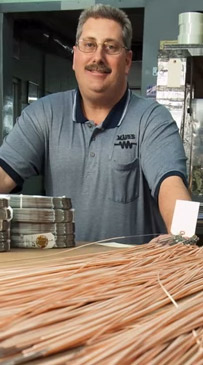 If you want a lower tone, you can have either a single large copper wound string or 2 smaller copper wraps to achieve the same mass. There’s a lot of debate – some manufacturers would like single wound strings while another might do 2 small wraps. We simply make custom strings to the manufacturer’s specifications. Those decisions regarding double or single wraps are part of the “scale” of a piano that are made at the design level.
If you want a lower tone, you can have either a single large copper wound string or 2 smaller copper wraps to achieve the same mass. There’s a lot of debate – some manufacturers would like single wound strings while another might do 2 small wraps. We simply make custom strings to the manufacturer’s specifications. Those decisions regarding double or single wraps are part of the “scale” of a piano that are made at the design level.
I just wanted to thank Andy Wilson for giving us a few insights as to the industry of making piano strings. There are very few companies globally who have the capacity to make the quality with tolerances as fine and consistent for piano making. Congrats to Mapes for continuing this pursuit of excellence for over 100 years.
To learn more about Mapes Piano String Company, you can find their contact and ordering information on their website: Mapes Strings
The Mapes Piano String Company
#1 Wire Mill Road
Elizabethton, TN 37643
Phone: 423-543-3195
More Piano Articles

During the performance of Jacob Collier at the most recent NAMM show I was reminded that music makes us human, that beauty binds us together as a collective, and that the reason the music industry exists is to aid in the creation of art. I needed that reminder without which, the annual trade show featuring many of the great piano makers is just the sale of wares. I believe that people are feeling the uncertainty ...
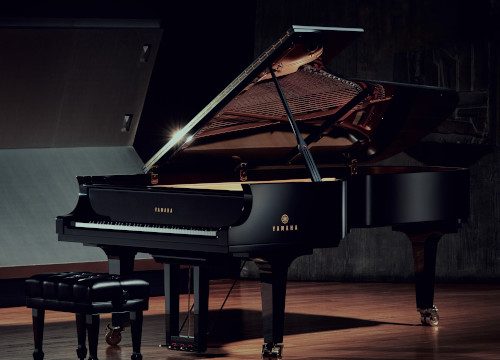
I used to have a teacher who would frequently say, “For every single grade point PAST 80%, it takes as much effort as the FIRST 80.” I believe this statement to be true from experience. The first 80 is the easiest. Chipping away at every point past that is the challenge. The bulk of the work can bring a project into shape but it’s the pursuit of excellence, that’s where the challenge lies. Yamaha is ...

The value of a piano is obvious ~ it’s the music that you make with it. But often, families are going through life changes which involve a house move and unfortunately, the piano needs to be sold. They invariably ask the question, “What are we going to do about the piano?” This question comes up because, as you can imagine, they’re not easy to move. We don’t simply pack them away in a cardboard box ...

You’ve been playing your piano for years now and the time has come to seriously consider downsizing the house and move into a condo. But what do you do with the piano? You love your piano and can’t imagine life without it and besides, you absolutely hate the idea of playing a digital keyboard. Many people don’t know that you can add digital functionality without compromising your existing piano. Yes, it is completely possible to ...

Many years ago, I remember seeing a piano in a museum similar to the one shown above (built in 1787 by Christian Gottlob Hubert. On display at Germanisches Nationalmuseum - Nuremberg, Germany). I have often wondered why acoustic portable pianos never really took off. Although we've seen more portable keyboard instruments like harpsichords, accordions or electronic keyboards, they operate completely different from a traditional piano in that they either pluck the strings, use air with ...

This was the first year since covid that the National Association of Music Merchants (NAMM) trade show was back to its regular January date and, in fact the first show where it felt back to normal. How was it? To answer that, I'm going quickly review the piano market over the last few years. Piano sales boomed during covid. Think about it - everyone was at home and with time on their hands, many turned ...